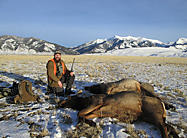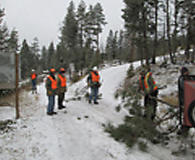By Jim Vashro
I’ve lost three hunting spots on corporate timberlands in the last two years. I’ve always appreciated the privilege of hunting those lands but knew they could be sold. One sale blocked a road leading to thousands of acres of US Forest Service where I’ve hunted for over 30 years. The hunt for new spots is hindered by a rash of new “No Trespassing” signs.
Public lands, owned by you and me, are our ace-in-the-hole for recreating. A couple of proposed bills on Fish, Wildlife and Parks’ Habitat Montana program this legislative session would ban fee title purchases, put conservation easements under final State Land Board approval and require no net gain of state lands. Who thinks we have too much, much less enough, public land?
For 30 years Habitat Montana has been a win-win for recreation and timber management. F.H. Stoltze and Stimson Lumber have been leaders in negotiating conservation easements that maintain their logging while protecting water, wildlife and access. The recent conservation easement with Southern Pines Plantations on Dredger Ridge more than doubled the effectiveness of the Lost Trail National Wildlife Refuge. Over the years non-governmental organizations acquired and transferred tens of thousands of acres of timberlands to agencies in the Stillwater, Swan, Clearwater, Lolo and lower Clark Fork. Two parties just purchased over 400,000 acres of Southern Pines Plantation west of Kalispell, fortunately, they seem open to discussing options. Purchase of the proposed 800 acre Bad Rock WMA near Columbia Falls would protect deer, elk, grizzly bears, waterfowl and provide hunting access for youth and persons with disabilities. The alternative is a subdivision where wildlife and the public aren’t as welcome.
FWP owns 388,000 acres of land and has 563,000 acres under conservation easement under Habitat Montana, along with state parks and fishing access sites. That is 1 percent of Montana. That is a sore spot for some who don’t believe agencies should own any land. FWP has never had a lot of money for lands so it has had to be very strategic. Acquired lands had to provide exceptional habitat and/or substantial public access and undergo extensive public scrutiny.
To start, a willing landowner must step forward. Landowners may want a conservation easement to keep the family ranch afloat. In some cases, they no longer want to own the lands but want the lands they’ve nurtured for a lifetime available for wildlife and public access. Proposed lands have to pass extensive analysis, two votes by the Fish and Wildlife Commission and have broad public input and support.
We’re talking about places like the Sun River Game Range, Freezeout Lake, Wildhorse Island, Lewis and Clark Caverns, Makoshika, Madison Buffalo Jump, Bannack and the Thompson Chain of Lakes. These special places are part of the fabric of Montana, preserving history, geology, wildlife, access and drawing visitors who spend money and support jobs.
Governor Gianforte lists protection of public land and increasing access among four core principles guiding his Administration. Outdoor recreation is a $7.1 billion force in Montana with Habitat Montana lands a major contributor. But to grow our economy, protect public land and increase public access, Habitat Montana needs additional revenue and no new restrictions on land acquisition or burdensome bureaucracy on conservation easements. Habitat Montana is an intersection of private and public property rights that works to benefit all of us. Montanans are paying attention and should fight any bills that would crimp or undo our best conservation and access program.
Jim Vashro is a retired fisheries biologist, president of Flathead Wildlife and Board member of the Montana Wildlife Federation





